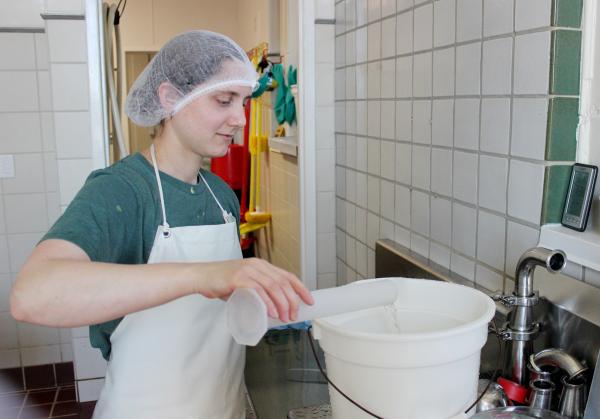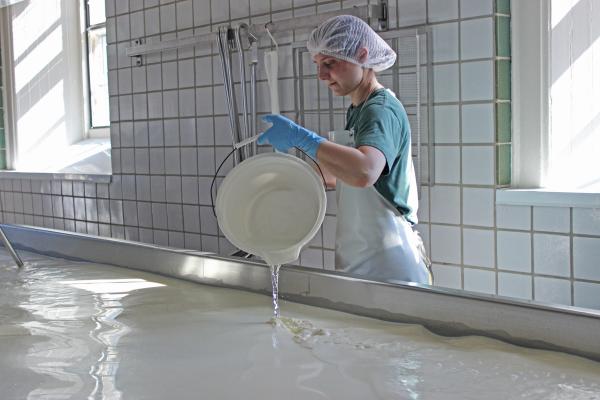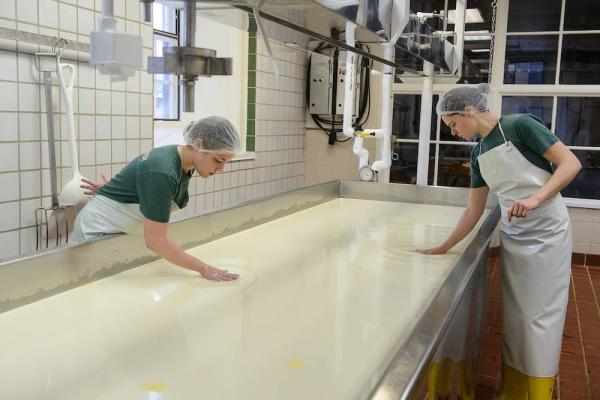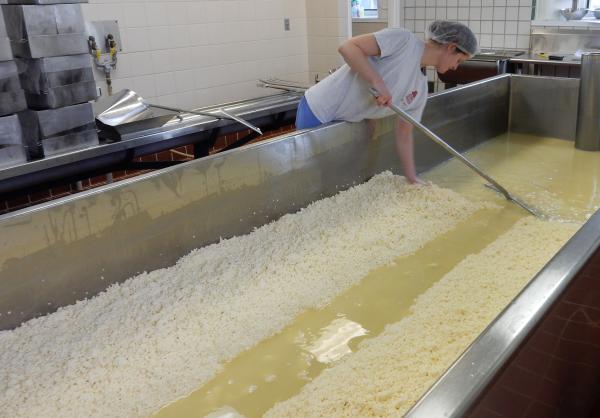Demystifying rennet, a key ingredient in cheesemaking
Originally posted April 16, 2019 before COVID-19 and social distancing.
We all know the main ingredient in cheese is milk (and we spend a lot of our time talking about it), but what else is in cheese? Most cheeses are comprised of milk, salt, cultures and rennet. Rennet is the most fascinating of these ingredients, yet it is a mystery to many.
Although the origins of cheesemaking are murky and still much debated, one of my favorite “origin tales” is that of the nomadic shepherd who was traveling with milk in a sack made from the stomach of a young animal. Upon arriving at his destination, the shepherd went to take a swig of milk only to find that it had curdled into a delicious solid. While this is probably just a fable, it still speaks to a huge discovery in the science of cheesemaking! Something magical happens to milk in the stomachs of young ruminants that helps cheesemakers achieve our primary objective: to extend milk’s “shelf life”. Rennet is the magic!
But first, a little science primer. Milk is an emulsion of fat, protein, sugar and minerals suspended in water. Cheesemakers use one of a few different methods to trigger a chemical reaction that causes coagulation, transforming liquid milk into a solid coagulum, or curd. Coagulation occurs when proteins clump together, trapping fat and other solids like a sponge. For cheddar, a hard aged cheese, we use enzymatic coagulation--by adding rennet. For more on other methods of coagulation, check out this great article on Cheese Science Toolkit
Phew! Now that some of the chemistry is out of the way, what exactly is rennet? And where did it come from? Rennet is the general name for enzymes that act on proteins in milk. It’s purpose in a ruminant’s stomach is to curdle milk for easier digestion, the same way it curdled our shepherd’s drink. Rennet serves the same purpose in cheesemaking: it triggers coagulation.
There are several types of rennet. At Shelburne Farms, we utilize traditional calf rennet. Calf rennet contains two enzymes, chymosin and pepsin, in a natural ratio that is suitable for our style of cheese. (Chymosin causes coagulation, pepsin has impacts on the aging process.) This traditional rennet has more reliable results in yield, as well as flavor profile, leading to less defective cheese. It is also a natural and non-GMO option that exemplifies our efforts to be sustainable by utilizing all parts of the animal.
In some cultures, vegetable and plant rennet has been used to coagulate milk. In India, where the cow is revered for religious reasons, fruit trees were used. Many Spanish sheeps’ milk cheeses use thistle and cardoon rennets. One drawback of these coagulants is they may lead to bitter and undesirable flavors in cows’ milk cheeses.
A demand for an inexpensive and reliable alternative to calf rennet led to the development of a genetically modified bacterium that can produce rennet enzymes through fermentation, called fermentation produced chymosin. In 1990, Pfizer successfully produced a chymosin that is genetically identical to the chymosin found in calf rennet. It is filtered from the bacteria in which it’s grown and isolated. Fermentation produced chymosin does not contain pepsin, so for our purposes, it does not have the exact same impact on the aging process.
Calf rennet is now the only rennet we use here as it is best for the flavor profile we are seeking. We have used fermentation produced chymosin at Shelburne Farms in the past, and we believe the product is safe and reliable, and can be part of a healthy food system. Debate on whether these enzymes are effectively a genetically modified organism is ongoing. As of 2008, according to the culture houses who produce these products, 80-90 percent of cheeses in the United States and Britain utilize fermentation-produced chymosin. At the same time, it has been banned in several countries that do not allow genetic engineering of food products.
I hope this introduction to rennet helps to demystify this important cheese ingredient. As with all our food choices, understanding how a product is made can help us make more informed decisions. Still, the world of rennet is particularly complicated, both scientifically and chemically, and it raises important questions around food system health. For small cheese makers in Vermont, the choice of which rennet to use is not a simple one.
If you want to dive even deeper into this topic, check out the entry on “rennet” in the Oxford Companion to Cheese, edited by UVM professor Catherine Donnelly, with a forward by Jasper Hill Farm founder Mateo Kehler. UVM professor Paul Kindstedt has written two definitive books on cheese that cover rennet at length, American Farmstead Cheese and Cheese and Culture. (You can find copies at our Welcome Center and Farm Store.)



